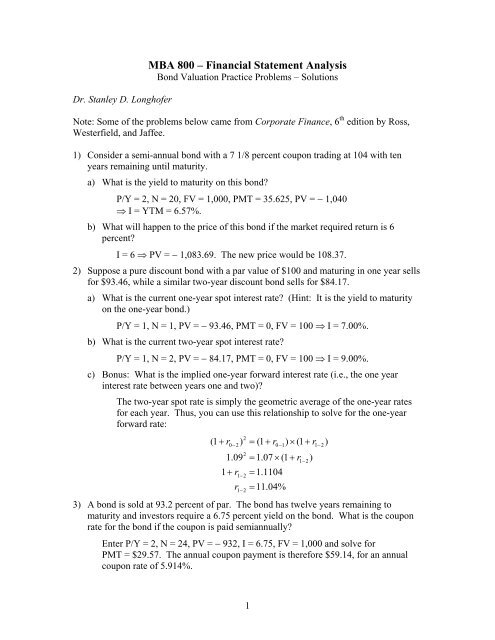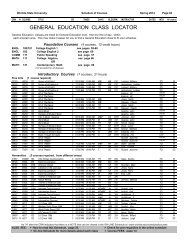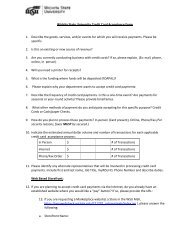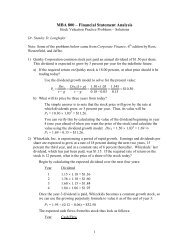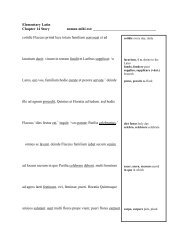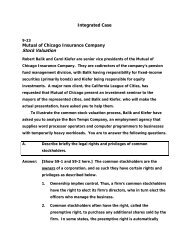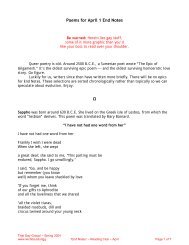Time Value of Money Homework Solutions
Time Value of Money Homework Solutions
Time Value of Money Homework Solutions
Create successful ePaper yourself
Turn your PDF publications into a flip-book with our unique Google optimized e-Paper software.
Dr. Stanley D. Longh<strong>of</strong>er<br />
MBA 800 – Financial Statement Analysis<br />
Bond Valuation Practice Problems – <strong>Solutions</strong><br />
Note: Some <strong>of</strong> the problems below came from Corporate Finance, 6 th edition by Ross,<br />
Westerfield, and Jaffee.<br />
1) Consider a semi-annual bond with a 7 1/8 percent coupon trading at 104 with ten<br />
years remaining until maturity.<br />
a) What is the yield to maturity on this bond?<br />
P/Y = 2, N = 20, FV = 1,000, PMT = 35.625, PV = − 1,040<br />
⇒ I = YTM = 6.57%.<br />
b) What will happen to the price <strong>of</strong> this bond if the market required return is 6<br />
percent?<br />
I = 6 ⇒ PV = − 1,083.69. The new price would be 108.37.<br />
2) Suppose a pure discount bond with a par value <strong>of</strong> $100 and maturing in one year sells<br />
for $93.46, while a similar two-year discount bond sells for $84.17.<br />
a) What is the current one-year spot interest rate? (Hint: It is the yield to maturity<br />
on the one-year bond.)<br />
P/Y = 1, N = 1, PV = − 93.46, PMT = 0, FV = 100 ⇒ I = 7.00%.<br />
b) What is the current two-year spot interest rate?<br />
P/Y = 1, N = 2, PV = − 84.17, PMT = 0, FV = 100 ⇒ I = 9.00%.<br />
c) Bonus: What is the implied one-year forward interest rate (i.e., the one year<br />
interest rate between years one and two)?<br />
The two-year spot rate is simply the geometric average <strong>of</strong> the one-year rates<br />
for each year. Thus, you can use this relationship to solve for the one-year<br />
forward rate:<br />
( 1<br />
+ r<br />
0−<br />
2<br />
)<br />
1.<br />
09<br />
1+<br />
r<br />
2<br />
2<br />
1−2<br />
r<br />
1−2<br />
1<br />
=<br />
( 1<br />
+ r<br />
0−1<br />
) × ( 1+<br />
r<br />
= 1.<br />
07 × ( 1+<br />
r<br />
= 1.<br />
1104<br />
= 11.<br />
04%<br />
3) A bond is sold at 93.2 percent <strong>of</strong> par. The bond has twelve years remaining to<br />
maturity and investors require a 6.75 percent yield on the bond. What is the coupon<br />
rate for the bond if the coupon is paid semiannually?<br />
Enter P/Y = 2, N = 24, PV = − 932, I = 6.75, FV = 1,000 and solve for<br />
PMT = $29.57. The annual coupon payment is therefore $59.14, for an annual<br />
coupon rate <strong>of</strong> 5.914%.<br />
1−2<br />
)<br />
1−2<br />
)
4) The Sue Fleming Corporation has two different bonds currently outstanding. Bond A<br />
has a face value <strong>of</strong> $40,000 and matures in 20 years. The bond makes no payments<br />
for the first six years and then pays $2,000 semiannually for the subsequent eight<br />
years, and finally pays $2,500 semiannually for the last six years. Bond B also has a<br />
face value <strong>of</strong> $40,000 and a maturity <strong>of</strong> 20 years; it makes no coupon payments over<br />
the life <strong>of</strong> the bond. If the required rate <strong>of</strong> return is 12 percent compounded<br />
semiannually, what is the current price <strong>of</strong><br />
a) Bond A?<br />
Use the irregular cash flow function in your financial calculator to value this<br />
bond:<br />
b) Bond B?<br />
Dates Payment Frequency<br />
1-12 0 12<br />
11-28 2,000 16<br />
29-39 2,500 11<br />
40 42,500 1<br />
There are several points to note about these entries. First, the periods are 6month<br />
intervals because <strong>of</strong> the semiannual payments. Second, it is important<br />
to put in the 12 periods without payments; otherwise, your financial calculator<br />
won’t discount the later payments correctly. Finally, when the bond matures<br />
it pays back its face value <strong>of</strong> $40,000. At the same time, it makes its final<br />
coupon payment. These two payments are added together and listed as the<br />
final cash flow. Don’t simply put the $40,000 payment as an additional cash<br />
flow in period 41. You will get the wrong answer!<br />
When you solve for the PV, you need to give your calculator the periodic rate,<br />
not the annual rate. This is because your payments occur at semiannual<br />
intervals. Solving for the PV <strong>of</strong> these cash flows with a 6 percent discount<br />
rate gives us PV = $18,033.86.<br />
You can use the TVM function in your calculator to solve for the value <strong>of</strong> this<br />
pure discount bond: P/Y = 2, N = 40, I = 12, PMT = 0, FV = 40,000 ⇒<br />
PV = − 3,888.89.<br />
5) Assume the following spot rates:<br />
Maturity Spot Rates (%)<br />
1 5<br />
2 7<br />
3 10<br />
What are the forward rates over each <strong>of</strong> the three years?<br />
f 5.<br />
00%<br />
, the current spot rate over the first year.<br />
1 =<br />
2
3<br />
%<br />
04<br />
.<br />
9<br />
1<br />
05<br />
.<br />
1<br />
07<br />
.<br />
1<br />
1<br />
)<br />
1<br />
(<br />
)<br />
1<br />
(<br />
2<br />
1<br />
2<br />
2<br />
2<br />
=<br />
−<br />
=<br />
−<br />
+<br />
+<br />
=<br />
r<br />
r<br />
f .<br />
%<br />
25<br />
.<br />
16<br />
1<br />
07<br />
.<br />
1<br />
10<br />
.<br />
1<br />
1<br />
)<br />
1<br />
(<br />
)<br />
1<br />
(<br />
2<br />
3<br />
2<br />
2<br />
3<br />
3<br />
3<br />
=<br />
−<br />
=<br />
−<br />
+<br />
+<br />
=<br />
r<br />
r<br />
f .


